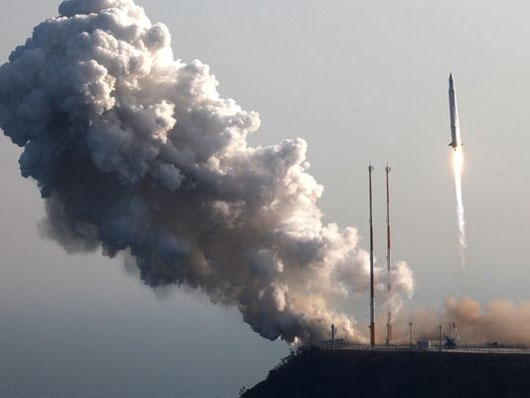South Korea spends $ 1.85 billion to develop new boosters
South Korea has just planned to launch the rocket produced by the country to bring satellites into orbit by 2020, Xinhua reports information from the Korean government agency on November 26.
>>>Korea announced the launch of the satellite successfully
The National Space Agency of Korea on November 26 approved an ambitious new space research development program, building a space rocket, taking the probe to land on the moon. , international cooperation in exploring Mars and asteroids .
Accordingly, Korea is aiming to launch self-made boosters with satellites weighing about 1.5 tons to put into orbit before June 2020, 15 months earlier than the previous plan.

Naro-1 missiles left the launch pad at the Naro Space Center in January.South Korea has proposed a plan to develop larger boosters, 15 months earlier than the previous plan - (Photo: AFP)
The Yonhap news agency quoted information from the Ministry of Science, Information Technology and Korea's Future Plan, saying the government will spend a total of 1.96 trillion won (about US $ 1.85 billion) to finance Support for the new program.
Reportedly, on January 30, South Korea launched its rocket launcher KSLV-1 (Korea Space Launch Vehicle-1, also known as Naro-1) weighing 170 tons from the Naro Space Center on the south coast. South Korea, successfully bringing 2C satellite Science and Technology (STSAT-2C) weighs 100kg into space.
However, the KSLV-1 missile is not made by Korea itself, but by Russian assistance. Specifically, the second floor of Naro-1 - a two-stage rocket using solid fuel - was built by the Korea Aerospace Research Institute, while the first floor was built by the Khrunichev Space Research and Production Center. (Russia) done.
According to AFP, South Korea's space ambition over the past few years has been restrained by US allies because Washington is concerned that this East Asian country will develop a space rocket program will entail arms racing in the region. , especially for DPRK.
Meanwhile, Japan and China had their first satellite launch in the 1970s, India was successful in the 1980s. South Korea, Asia's fourth-largest economy, was lacking in support. America had to lag behind.
- Korea aims to space
- Poisonous: Korea is as beautiful as paradise that surprised the world
- South Korea accused Intel of monopoly
- South Korea seized two people to distribute 1.6 billion spam
- South Korea discovered the third bird flu drive
- South Korea fears the same disaster
- 11 billion VND for biotechnology applications in agriculture
- Korea will launch satellites from the Pacific Ocean
- South Korea uses robots to manage prisoners
- Korea is about to launch Arirang-3 multi-function satellite
- Big storm swept through Korea, at least 16 people died
- The most powerful earthquake in history, Korea stopped 4 nuclear reactors
 Van Allen's belt and evidence that the Apollo 11 mission to the Moon was myth
Van Allen's belt and evidence that the Apollo 11 mission to the Moon was myth The levels of civilization in the universe (Kardashev scale)
The levels of civilization in the universe (Kardashev scale) Today Mars, the sun and the Earth are aligned
Today Mars, the sun and the Earth are aligned The Amazon owner announced a secret plan to build a space base for thousands of people
The Amazon owner announced a secret plan to build a space base for thousands of people